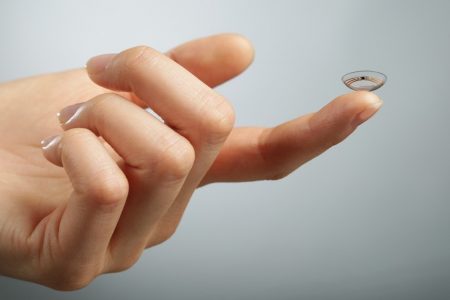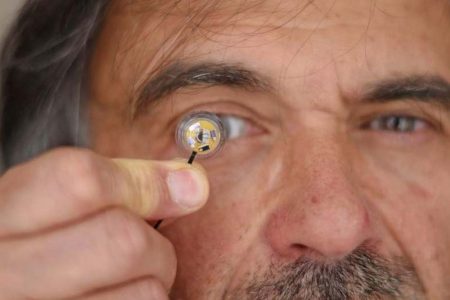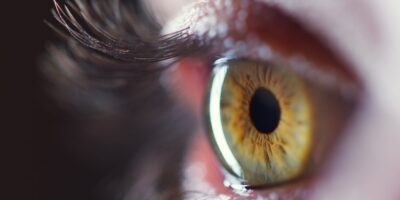Editors Blog – Eyeing up the future
In this month’s blog, Caroline Hayes takes a close look at smart contact lenses. These contact lenses exceed the limits of the doomed Google glasses project, with health monitoring as well as augmented reality vision for soldiers.
Research into smart contact lenses has produced some innovative wearable devices. They have medical and healthcare uses but can also be used like micro-computers, using augmented reality (AR) to create a computer interface for the wearer.
For healthcare, the contact lens, by design, has access to physiological changes in the body and so can be used to monitor and report changes. In an interview with Gizmodo Australia, Arthur Ho, Chief Scientist and Innovation Officer at the University of New South Wales’ Brien Holden Vision Institute said that contact lenses, by virtue of being bathed in fluid, the wearer’s tear film, can detect and measure physiological states in ways that are a wrist worn device cannot.
Google seems determined to get to grips with eyewear! Its Google Glasses were withdrawn in 2015, due to privacy concerns and its life sciences division, Verily stopped development of a smart contact lens for diabetes sufferers in November 2018, because the measurements of glucose levels in tears was not accurate enough compared to testing blood.
Work into diabetes control using smart contact lenses continues in South Korea, however, where researchers have created a microchip which could detect diabetes and treat diabetic retinopathy – a condition in which glucose causes blood vessels to swell and leak fluid into the back of the eye, and which can lead to blindness.
The microchip monitors sugar levels via the blood vessels behind the eyelids and issues a warning when they rise. In a recent study, the lenses accurately detected glucose levels from the tears of rabbits with diabetes.

Figure 1: Vision is in the eye of the beholder (Picture: Google)
In 2019, Verily raised $1bn to continue developing ways to integrate wireless electronics and miniaturised sensors into a contact lens and different form factors for lenses.
Another company, Mojo Vision is thinking along similar lines. It is developing computer-integrated contact lenses which will replace today’s bulky augmented reality (AR) headsets.
Its Mojo Lens is a contact lens which magnifies text for wearers with poor or impaired vision. It is controlled by eye movements and can display pop-up menus to sow text or graphics.
Just as glasses are now used in retail and warehouse logistics, the smart contact lens can be used to help navigate shops and warehouse or storage plants as well as for outdoor navigation when hiking or travelling.
Mojo Vision’s Steve Sinclair, senior vice president of Product & Marketing at Mojo vision, told Gizmodo Australia: “We believe that information should be there when you need or want it, and then disappear when you don’t. Whether it’s remembering specific steps for a hands-on procedure, getting walking directions from a meeting to a restaurant, checking on your house remotely, or seeing in a dark garage, we envision people using this most when they need information or answers but want to stay engaged and ‘eyes up’ in their surroundings.”
The company showed a prototype at the beginning of this year, in which eye movement operates devices, concentrating both eyes on an icon turns on, say the TV and looking away turns it off.
The lenses use a tiny projector to send information to the wearer’s retinas. It can be used to provide overlay text and icons to enhance impaired vision and may assist in mobility, reading and low light conditions.
The projector and lens are always centred on the fovea which is located in the retina and is the area that provides the clearest vision. According to the Mojo Vision, the proprietary lens, or femtoprojector, has a large depth of vision to ensure that everything it projects – for example the name of the person you are looking at – is always in focus.
The prototype uses a pair of special, tethered glasses to beam information to the display in the lens. The final version is expected to need another wearable to control it and to communicate between the lenses and a smartphone.
There are no details of a commercial launch date, which would doubtless by subject to health approvals, although the US Food and Drug Administration (FDA) has already designated Mojo Lens as a Breakthrough Device.
Building on research
University labs have been putting the building blocks for smart contact lenses for some time. In 2016, a team of researchers at the University of South Australia’s Future Industries Institute developed a prototype lens which could conduct electricity. This led people to think that ultra-miniature computing that maintained levels of performance and complexity was possible.
The real advance will be to wear contact lenses with an AR interface. Last year, the French technology university, IMT Atlantique, announced the development of a wireless contact lens which provides augmented vision assistance and relays visual information wirelessly (Figure 2). The lens incorporates a flexible micro battery sufficient to continuously stream video wirelessly for hours. This has possibilities for helping soldiers in battlefields to identify locations using a map without shifting their vision from an area, check inventory and relay information to other battalions of command centres.

Figure 2: Professor Jean-Louis de Bougrenet de la Tocnaye holds the contact lens, with battery developed at IMT Atlantique (Picture: IMT Atlantique)
Another company, Innovega, based in Washington, USA, has released details of its iOptiks which are contact lenses which project digital images on to a pair of glasses for a “miniaturised heads up display” to enhance the wearer’s normal vision.
Another innovation is a US Department of Defense’s DARPA (Defense Advanced Research Projects Agency)-funded contact lens which magnifies objects by activating a thin telescope when the wearer winks their right eye. The telescope returns to its original position when the left eye winks. This research was conducted at the École Polytechnique Fédérale de Lausanne (EPFL) in Switzerland. DARPA’s interest was for its use in warfare but this interest has now shifted to the lens being used by elderly wearers to improve their vision.
Challenges to overcome
There are design challenges to smart contact lenses; even conventional contact lens wearers can report discomfort. As well as research into applying microcircuits onto the small surface area, there is ongoing work into bio-compatible materials which will allow oxygen to the eye so that it can ‘breathe’ and to prevent dryness.




